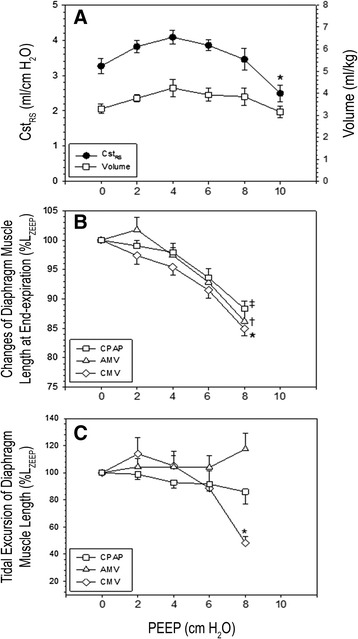Figure 1.

Data gathered at varying positive end-expiratory pressure levels. (A) Static compliance of the respiratory system (CstRS) and volume normalized for body weight. (B) Changes of costal segmental diaphragm muscle length at end expiration expressed as a percentage of that at positive end-expiratory airway pressure (PEEP) of 0 cmH2O (LZEEP). (C) Tidal excursion of segmental diaphragm muscle length expressed as a percentage of that at LZEEP. AMV, Assist-control mechanical ventilation; CMV, Controlled mechanical ventilation; CPAP, Continuous positive airway pressure. Paralysis was incorporated only in experimental results shown in (A). Values are mean ± SE (n = 4 animals in each experiment). (A) *P < 0.05 PEEP of 10 cmH2O compared with 8, 6, 4 and 2 cmH2O. (B) ‡P < 0.01 CPAP of 8 cmH2O compared with CPAP of 6, 4, 2 and 0 cmH2O; †P < 0.01 AMV with PEEP of 8 cmH2O compared with PEEP of 6, 4, 2 and 0 cmH2O; *P < 0.01 CMV with PEEP of 8 cmH2O compared with PEEP of 6, 4, 2 and 0 cmH2O. (C) *P < 0.01 CMV with PEEP of 8 cmH2O compared with AMV with PEEP of 8 cmH2O and with various PEEP and CPAP levels (0 to 6 cmH2O).
